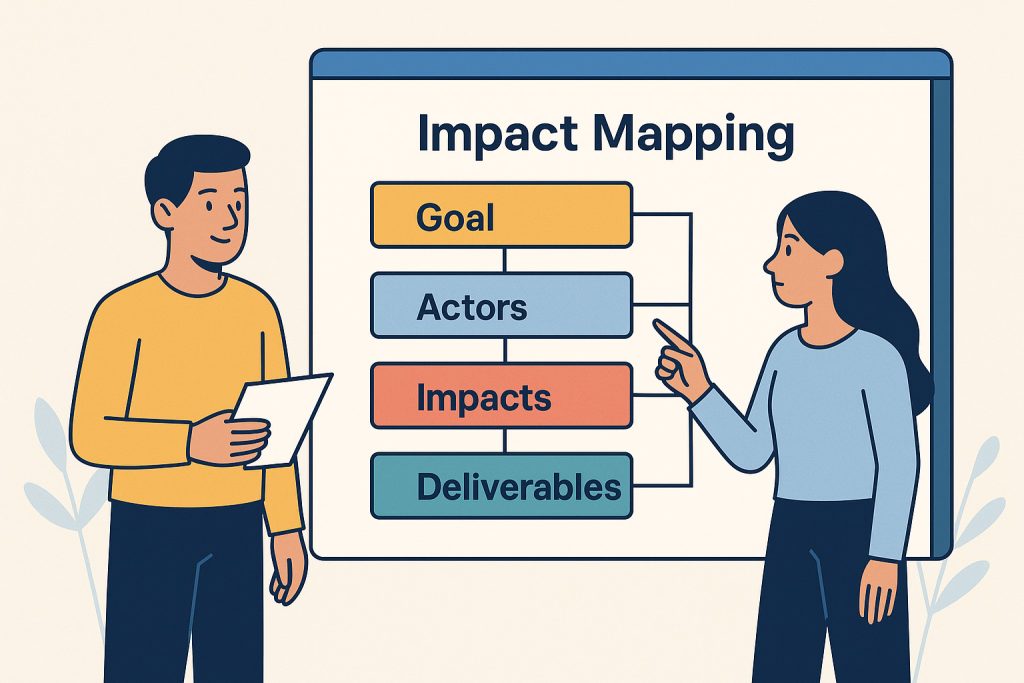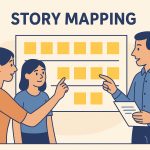In the fast-paced world of product development, teams often find themselves building features simply because they seem like good ideas, or because competitors have them, or worse—because someone in a meeting once suggested them. This scattered approach can lead to bloated products that lose sight of their original purpose. Impact Mapping offers a refreshing alternative: a visual strategy planning method that keeps every feature decision anchored to meaningful business goals.
Introduced by Gojko Adzic in 2012, Impact Mapping has become an essential tool for product teams seeking clarity in their development decisions. Rather than starting with features and hoping they’ll be useful, this approach begins with the end goal and works backward, creating a clear chain of reasoning for every element that makes it into the product.
What is Impact Mapping?
At its core, Impact Mapping shares DNA with other visual planning methods like story mapping and mind mapping, but with a crucial difference: everything revolves around achieving a specific, measurable goal. The method creates a visual pathway from your primary objective to the specific features needed to achieve it, identifying the key players and their roles along the way.
The beauty of this approach lies in its simplicity. By placing the goal at the center of all planning discussions, teams spend more time defining what success actually looks like rather than jumping straight into solution mode. This focus prevents the all-too-common scenario where teams build impressive features that don’t move the needle on what matters most.
The goal itself must meet the SMART criteria to be effective. It should be specific enough that everyone understands exactly what’s being achieved, measurable so progress can be tracked, action-oriented to drive behavior, realistic given available resources, and timely with clear deadlines. Without a solid goal foundation, even the most thorough Impact Mapping exercise can lead a project astray.
Impact Mapping becomes even more valuable when conducted with different groups within an organization. Running separate sessions with executives, product teams, sales, and customer success often reveals interesting patterns of overlap and divergence. These differences highlight organizational assumptions and biases that might otherwise remain hidden, creating opportunities for deeper alignment around strategy and customer understanding.
What Purpose Does Impact Mapping Serve?
Impact Mapping serves different constituencies within an organization, each gaining unique value from the exercise. For executive teams, it provides a clear line of sight between product investments and business outcomes. Instead of reviewing endless feature lists and wondering how they connect to company objectives, leadership can see exactly how each development dollar contributes to goal achievement. This transparency helps shut down scope creep and resource allocation debates that stray from core objectives.
Product development teams benefit from having every feature directly tied back to goals. This connection acts as a natural filter against feature creep—if something doesn’t emerge from the Impact Mapping process, it probably doesn’t belong in the product. The visual nature of the method also makes it easier to explain prioritization decisions to stakeholders, reducing the friction that often comes with saying “no” to requested features.
Strategic customers can also benefit from impact maps as educational tools that explain feature prioritization decisions. When customers understand the reasoning behind development choices, they’re more likely to support the product direction. Some companies even invite customer advisory boards to participate in their own Impact Mapping exercises, creating shared understanding and buy-in for the product roadmap.
Why is Impact Mapping Important for Product Managers?
Perhaps most importantly, Impact Mapping helps companies avoid the common trap of building solutions in search of problems. Many products begin with clear objectives but gradually morph over time as new ideas get added without strategic consideration. The result is often products that struggle with market fit or carry unnecessary complexity that confuses users and dilutes the core value proposition.
Impact Mapping helps product teams maintain laser focus on their primary objective by ensuring everything maps back to that central goal. If a feature doesn’t emerge naturally from the Impact Mapping process, it raises serious questions about whether it belongs in the product at all. This disciplined approach prevents the feature bloat that often accompanies successful products as they mature.
The method also serves as an excellent communication tool for explaining prioritization decisions to stakeholders throughout the organization. Since Impact Mapping is inherently visual and goal-focused, it’s difficult to argue with the logic chain it creates. Stakeholders can see exactly why certain features receive priority while others don’t, reducing political friction around resource allocation.
However, Impact Mapping relies heavily on assumptions about actor behavior and market dynamics. Teams must remember that their maps represent hypotheses to be tested rather than certainties to be implemented. The real value comes from using these assumptions as a foundation for research and experimentation that validates or refutes the underlying logic.
Key Benefits for Product Managers:
- Focus maintenance: Keeps teams aligned on primary objectives
- Feature filtering: Provides clear rationale for inclusion or exclusion decisions
- Stakeholder communication: Makes prioritization logic transparent and defensible
- Assumption identification: Surfaces beliefs that need validation through research
How Do You Build an Impact Map?
Creating an Impact Map requires discipline to move through each stage sequentially, as each builds upon the previous one. Skipping ahead defeats the purpose entirely—the goal is to identify deliverables based solely on the logical progression through actors and their impacts. The visual structure starts with a single central element and branches outward, creating a tree-like diagram that maps the path from goal to specific features.
The sequential nature of the process is crucial. Teams that jump straight to deliverables miss the strategic thinking that makes Impact Mapping valuable. Each stage builds understanding that informs the next, creating a logical chain from high-level objectives down to specific implementation details.
The Four Essential Stages:
- Goals: Why are we doing this?
- Actors: Who can help us achieve this goal?
- Impacts: How do we want these actors to behave differently?
- Deliverables: What do we need to build to enable these behavior changes?
1. Goals = Why?
The goal sits at the nexus of your Impact Map, and it’s worth investing significant time to get this right. What exactly is the product trying to achieve? This isn’t about features or capabilities—it’s about the fundamental outcome that will determine success or failure.
A well-defined goal influences every subsequent decision in the exercise and, ultimately, in the product itself. Teams should resist the temptation to rush through goal definition, even if it means having several planning sessions dedicated just to this step. The clarity gained here pays dividends throughout the entire development process.
2. Actors = Who?
Actors encompass everyone who can influence whether your product achieves its goal. This goes well beyond end-users to include internal staff, distribution partners, industry influencers, and even potential obstacles. The key is granularity—rather than simply identifying “users,” consider whether you’re serving multiple user types, industries, or use cases that might require different approaches.
Don’t overlook actors who might not use the product directly but still influence its success. For instance, IT decision-makers who don’t use your software daily but control purchasing decisions, or customer support teams whose efficiency affects user satisfaction. Each actor represents a potential leverage point for goal achievement.
Consider also the actors who might stand in the way of success. Competitors, regulatory bodies, or internal stakeholders with conflicting priorities all play roles in whether your product achieves its objectives. Including these potential obstacles in your Impact Map helps ensure you’re building features that address real-world constraints.
3. Impact = How?
This stage shifts focus from what people currently do to what you want them to do differently. It’s a fundamental mindset change from typical user behavior modeling, which often focuses on existing tasks and workflows. Instead, Impact Mapping asks: what specific behavior change from each actor would advance your goal?
These impacts might include spending more money, recommending the product to others, completing tasks more efficiently, or spending more time engaged with your platform. Equally important is identifying behaviors that should remain unchanged—sometimes success requires certain actors to continue their current patterns while others change.
The key is being specific about the behavioral changes you’re seeking. Vague impacts like “be more satisfied” or “engage more” don’t provide enough direction for feature development. Instead, focus on observable, measurable behaviors that directly contribute to goal achievement.
4. Deliverables = What?
Finally, you identify the specific features, tools, and incentives that will drive the desired behavior changes. These deliverables emerge naturally from the preceding analysis rather than being imposed from external wish lists or competitive analysis. Each deliverable has a clear rationale chain: this feature enables this behavior from this actor, which contributes to this goal.
This approach doesn’t mean every deliverable identified will get built. Instead, it provides a prioritized backlog where each item’s contribution to goal achievement is explicit and can be evaluated against alternatives. Teams can then validate their assumptions through research and experimentation before committing development resources.
Consider a company looking to increase word-of-mouth marketing for their established product. The Impact Map might identify current users as key actors who could share benefits on social media, leading to deliverables like in-app social sharing prompts and hashtag campaigns. Future users might be incentivized to announce their adoption through sign-up discounts for social posts. Marketing staff could promote influential users by featuring them on company social channels. Each deliverable connects directly back to the central goal through a specific actor and desired behavior change.
Impact Mapping represents more than just another planning framework—it embodies a fundamental shift toward outcome-oriented product development. The method’s visual simplicity makes complex strategic relationships clear and actionable, while its collaborative nature ensures broad organizational alignment around goals and approaches. By forcing teams to explicitly connect every feature to goal achievement through specific actor behaviors, it eliminates much of the waste and confusion that plague traditional development approaches.
Conclusion
The assumptions built into any Impact Map require ongoing validation through user research, experimentation, and market feedback. Teams should treat their Impact Maps as living documents that evolve as they learn more about their users and market dynamics, ensuring the framework remains a valuable guide rather than a rigid constraint. When used thoughtfully, Impact Mapping transforms organizations from feature factories into goal-driven development engines that create genuine value for users and businesses alike.


